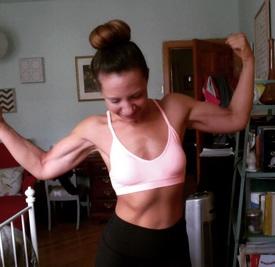Confused about how to measure waist - am I at risk or not?
Replies
-
I've noticed my waist getting slightly thicker since heavy lifting. I still have a layer of fat on top of the muscle, and was wondering how this would impact the measurement? Which fat takes longer to burn off? I'm genuinely curious if this would make a difference in this measurement? I definitely have room to improve, but it feels like my waist has gotten somewhat wider instead of narrower.
And to the OP..... It takes all kinds to make a community, online or otherwise. It's always the loudest voices that stand out the most, but often have the least value to contribute. Just my 2 cents. 0
0 -
I've noticed my waist getting slightly thicker since heavy lifting. I still have a layer of fat on top of the muscle, and was wondering how this would impact the measurement? Which fat takes longer to burn off? I'm genuinely curious if this would make a difference in this measurement? I definitely have room to improve, but it feels like my waist has gotten somewhat wider instead of narrower.
And to the OP..... It takes all kinds to make a community, online or otherwise. It's always the loudest voices that stand out the most, but often have the least value to contribute. Just my 2 cents.
Are you lifting at a surplus? What do you mean "which fat takes longer to burn off"? I'm not sure what kind of difference it would make in the measurement. If you have a thicker waist due to strength training, it would still be good to cut and keep your belly fat within a healthy range or whatever.0 -
Would visceral fat or subcutaneous fat burn off first? I can just research this myself though... I was just wondering if anyone contributing knew the answer. I've just started my cut this past week, so hopefully that will help with what's hanging around.0
-
And No, I wasn't lifting at what I considered a surplus 1650 while watching my macros, but I guess it's been at surplus for what I'm looking for.0
-
Because it crossed the line you tight-rope walk along. I've been very open and extremely polite in this thread, perhaps too polite. But I won't be called thick - either directly or indirectly. Especially by someone who can't even be bothered to read what I wrote.herrspoons wrote: »
.Wow, some properly thick people here, and I'm not talking about their physical appearance. If you are fat, you measure where the fat is at, i.e. the widest point. If you aren't fat, it doesn't matter where you measure, since none of this applies to you. Your waist could resemble a cartoon figure that was hit by a steamroller; if there is no fat there, you are not in the risk group regarding fat. Comprende?
And for the record, if your belly jiggles like a bowl full of jelly, then you are fat. If all you have is rock hard abs or maybe some loose skin and some soft bits, you are not fat.
I have reported this.
What for? It's on the money.
And as it is far too stressful to sift the kind, helpful advice from the advice of those who enjoy loading every sentence with dripping contempt, and tearing down new posters for the entertainment of onlookers and their own gratification, I certainly won't be posting here again. Which is a shame as I had a lot of support to give.
An interesting forum ruined by a few vile and spiteful people.
Unfortunately, this how many many people behave behind their computer screens and their keyboards.
I will put it like this... people just lack tact and politeness. OP I hope that you were able to get some good references on what you need to do to get your measurements down.
The appalling rudeness in this thread is not just evidence of people lacking tact and politeness though. It's evidence of people with antisocial personality disorders bullying and intimidating regular posters, and new posters like myself, typically by dressing up quite outrageous remarks as "tough love", and then getting endorsement for their behaviour when really they should be blocked and told to seek therapy.
My fat tummy is a lot less of a concern, overall, than the diseased minds that have revealed themselves here.
I have been a prolific poster on UK forums and I've never seen anything like it.
0 -
[quote="herrspoons;31057804"
Measuring it above that is akin to being one of those sad people who balance on the scales on their tiptoes whilst holding on to a wall to support their weight. Don't be that person.[/quote]
I'd sooner be that person than spend my time bullying people who are already vulnerable.
Is this you? Because this is how you come across in your posts.
"Antisocial personality disorder
A person with an antisocial personality disorder sees other people as vulnerable and may intimidate or bully others without remorse. They lack concern about the consequences of their actions.
Symptoms include:
lack of concern, regret or remorse about other people's distress
irresponsibility and disregard for normal social behaviour
difficulty in sustaining long-term relationships
little ability to tolerate frustration and to control their anger
lack of guilt, or not learning from their mistakes
blaming others for problems in their lives
The National Institute for Health and Care Excellence (NICE) has published guidelines on how people with antisocial personality disorders should be treated. For more information, see NICE: antisocial personality disorder (PDF, 250kb)."
0 -
It is so sad that so many threads get ruined because some people are rude and obnoxious. It is so off putting! Even if you are right about something there are polite ways of saying it but to continuously "shout" shows poor communication skills. I have kept reading this thread because there are some thoughtful replies among the drama. Ooci you look fabulous and have come such a long way already. You will get to your goal and I am sure some of the dangerous fat around the organs has melted away and will continue to do so
 0
0 -
It is so sad that so many threads get ruined because some people are rude and obnoxious. It is so off putting! Even if you are right about something there are polite ways of saying it but to continuously "shout" shows poor communication skills. I have kept reading this thread because there are some thoughtful replies among the drama. Ooci you look fabulous and have come such a long way already. You will get to your goal and I am sure some of the dangerous fat around the organs has melted away and will continue to do so

Warm thanks, to you and the other thoughtful, kind and generous people in this thread.
Most people know that overweight people get enough of a kicking without adding to it here.
0 -
I dunno about "Antisocial Personality Disorder" ... but I'm pretty sure lots a folks would put me in the Sociopath bucket.
I'm OK with that.0 -
There's a whole separate topic that could start here about the behaviour of people on internet forums, and the group dynamics that cause it.
But I'm not gonna go there. Instead I'll just say that everyone here who is trying to lose weight for their health is deserving of support and encouragement.0 -
arditarose wrote: »I went away for 24 hours and this thread blew up! I remember a similar thread about waist measurement getting like this. I'm not really sure why. All I can say is I have a vanity measurement: my smallest point. If the doctor would measure me I would assume it would be closer to my belly button.
Yeah same, I saw this thread pop back up on the board and thought I'd check back. 0_o OP unfortunately MFP doesn't come with a moron filter so please don't take these thread derailing chuff-nuts to heart.
0 -
SergeantSausage wrote: »I dunno about "Antisocial Personality Disorder" ... but I'm pretty sure lots a folks would put me in the Sociopath bucket.
I'm OK with that.
I coped with your lack of tact, I probably would punch you if I met you but at least you expressed pleasure that I was determined to go forward, and that was kind. It was the thick comment that really made my blood boil. And I'm pretty sure I can snap from sweet to psycho *kitten* without too much difficulty, so am hardly perfect.0 -
most people who are badass on the internet are wussy in person.0
-
Would visceral fat or subcutaneous fat burn off first? I can just research this myself though... I was just wondering if anyone contributing knew the answer. I've just started my cut this past week, so hopefully that will help with what's hanging around.
You can`t choose just one type to come off. The fat that comes off from being in a calorie deficit comes from everwhere, visceral and subcutaneous - which is fine. There are health benefits to fat loss for anyone who is obese or significantly overweight.
Combining diet deficit and exercise is the most effective way of specifically targeting abdominal fat - which is measured at the waist (http://onlinelibrary.wiley.com/doi/10.1038/oby.2004.95/full).
At least 30 minutes a day on average of moderate to intense exercise is recommended. Both weight training and aerobic traning are effective (http://ajcn.nutrition.org/content 60/5/695.abstract?ijkey=5d6a6bc31f6d12dd04c90db24e32a51b7be8398b&keytype2=tf_ipsecsha).
If you want specifically to lose visceral fat, you want to include dairy - especialy yogurt (http://onlinelibrary.wiley.com/doi/10.1038/oby.2004.67/full), whole grains (http://ajcn.nutrition.org/content/87/1/79.short), and fresh fruit and vegetables in your diet.
Even though these measures specifically address fat at the waistline, both subcutaneous and visceral fat will be lost. Good luck with your cut 0
0 -
MFP, please please please get the "Ignore Person" option back in play!!!0
-
SergeantSausage wrote: »I dunno about "Antisocial Personality Disorder" ... but I'm pretty sure lots a folks would put me in the Sociopath bucket.
I'm OK with that.
I coped with your lack of tact
Tact is both unnecessary, and vastly overrated.
0 -
SergeantSausage wrote: »SergeantSausage wrote: »I dunno about "Antisocial Personality Disorder" ... but I'm pretty sure lots a folks would put me in the Sociopath bucket.
I'm OK with that.
I coped with your lack of tact
Tact is both unnecessary, and vastly overrated.
Yes, Professor Higgins. But do prepare for the hurled slippers!
0 -
Inspired my this I measured my waist, and the widest point. I was further over the NHS guidelines than I thought. I have also tried on a pair of jeans that I bought a couple of years ago that were snug at the time. I can't get them fastened by about three/four inches so will use them to gauge my progress.
I only have 20lb or so to lose to put me mid range of my BMI but most of my weight is around my waist/belly. Given that you cannot spot reduce how do I ensure my waist measurement reduces to the acceptable range. I am quite small boned so I'm sure I would not be the exception to the rule.0 -
Malteaster wrote: »I only have 20lb or so to lose to put me mid range of my BMI but most of my weight is around my waist/belly. Given that you cannot spot reduce how do I ensure my waist measurement reduces to the acceptable range. I am quite small boned so I'm sure I would not be the exception to the rule.
Lifting weights, or other strength training exercises, will help you reduce body fat percentage. Yes, it will be all over, not just around your waist, but you'll see that waist measurement drop, too.
And nope, you're not the only one! I'm small-framed and short, too, and even though I also only have 15 pounds to go to get to mid-range of my BMI, my body fat % is also still far too high, and the core fat is still far too jiggly for my liking. I'm working on it. We can all huff and puff through it together.0
This discussion has been closed.
Categories
- All Categories
- 1.4M Health, Wellness and Goals
- 398.2K Introduce Yourself
- 44.7K Getting Started
- 261K Health and Weight Loss
- 176.4K Food and Nutrition
- 47.7K Recipes
- 233K Fitness and Exercise
- 462 Sleep, Mindfulness and Overall Wellness
- 6.5K Goal: Maintaining Weight
- 8.7K Goal: Gaining Weight and Body Building
- 153.5K Motivation and Support
- 8.4K Challenges
- 1.4K Debate Club
- 96.5K Chit-Chat
- 2.6K Fun and Games
- 4.8K MyFitnessPal Information
- 12 News and Announcements
- 21 MyFitnessPal Academy
- 1.5K Feature Suggestions and Ideas
- 3.2K MyFitnessPal Tech Support Questions








